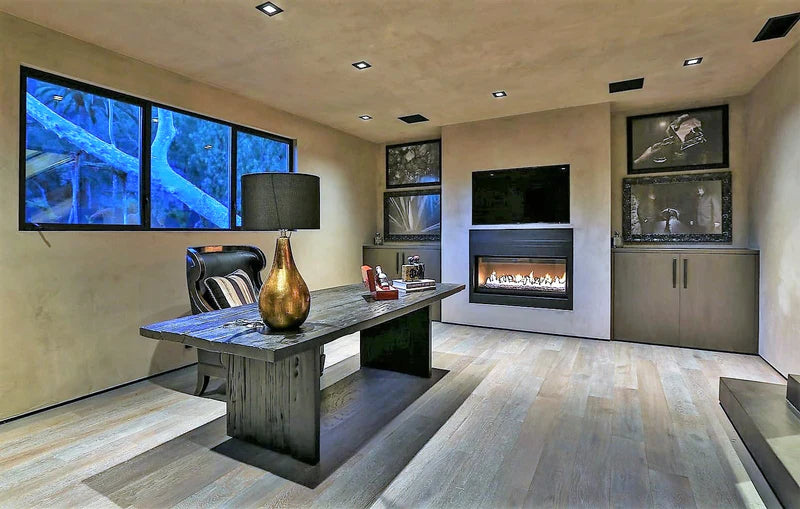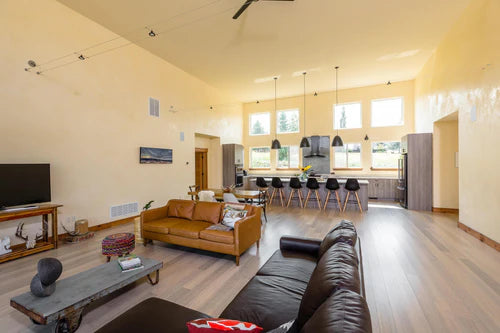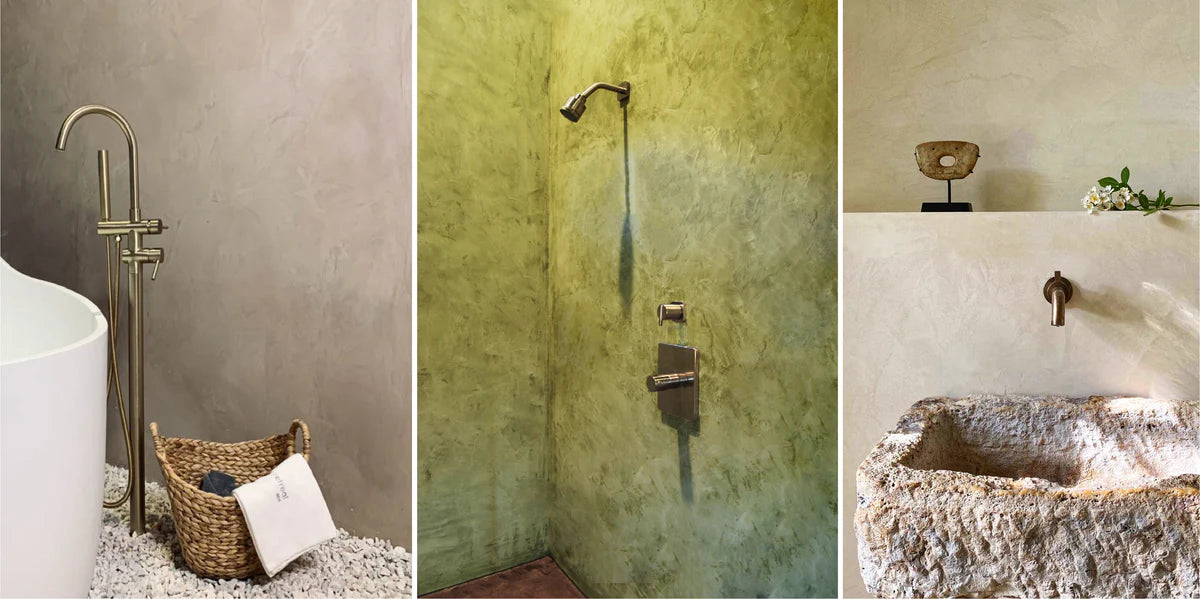Advantages of Lime Plaster in Modern Architecture

Key Takeaways
- Lime plasters and lime paint are unmatched in beauty, versatility, durability, longevity, and natural living
- Lime plasters and paint are very easy to repair and maintain
- Lime coatings are sustainable choice for modern construction
- It offers excellent breathability and moisture regulation
- The material has carbon-neutral properties
- Lime based coatings provide durability and longevity to structures
- It's versatile in design and compatible with various architectural styles
- The use of lime plaster promotes healthier indoor environments
- The natural properties of lime are very anti-microbial and anti-fungal
The Advantages of Lime Plaster and Lime Paint / Lime Wash in Modern Architecture
Traditional and authentic lime based coatings are unparalleled in beauty, versatility and sustainability. Lime plaster, a staple for thousands of years, is back in style for eco-friendly buildings. It's not just a throwback; it's a smart choice for architects and homeowners.
Lime plaster and lime paint mixes natural finishes with modern design. It has many benefits for today's buildings. It's eco-friendly and helps create beautiful, healthy living spaces, making it a top choice for builders.
Lime plaster and lime paint are top picks for sustainable building. This natural finish absorbs CO2, becoming part of a building's ecosystem.

A Brief History of Lime Plaster in Construction
Lime plaster has a long history that goes back thousands of years. It has been key in preserving history and in traditional plastering. Many civilizations have used it.
Ancient Origins and Traditional Uses
Lime has been used in buildings for over 12,000 years. The ancient Egyptians used it in the Great Pyramids. The Romans spread its use across their empire. The Colosseum is a lasting example of its strength.
Revival of Lime Plaster
In Europe's medieval and Renaissance times, lime plaster was at its peak. Buildings like Notre Dame Cathedral in Paris show its beauty. But, the 19th century's Portland cement made lime plaster less popular.
Yet, by the late 19th and early 20th centuries, lime plaster was back in use for restoration. Although cement was ideal for foundational construction, it worked poorly as a thinner surface finish coat due to its brittle nature.
Lime Plaster's Journey into Modern Architecture
Lime plaster is loved for being sustainable and having a traditional look. It's great because it lets air through which allows the building to breathe and filter air. Places like Thomas Jefferson's Monticello and Mission San Juan Capistrano show its lasting beauty.
Today, architects are bringing back lime plaster. They mix its history with new designs.
|
Time Period |
Key Development |
|
12,000+ years ago |
First use of lime as a building material |
|
2500 - 500 B.C. |
Phoenicians discover hydraulic mortars |
|
12th century |
Improvement in medieval mortar quality |
|
1756 |
John Smeaton discovers clay's importance in water-resistant lime |
|
1796 |
James Parker invents natural cement |
Environmental Benefits of Lime Plaster
Lime plaster is a top choice for eco-friendly buildings. It's known for its unmatched sustainable construction benefits. Let's look at why it's great for the planet.
Carbon Neutral Properties
Lime plaster production is low in CO2 emissions. This is much less than the aviation industry's 2 percent. Plus, lime production is carbon neutral. As it cures, it takes in CO2, turning back into limestone on the wall..
This process makes it last longer and boosts its green credentials.
Sustainable Production Process
Making lime plaster uses less energy than materials like Portland cement. Vasari, a manufacturer of lime plaster and lime paint, sources all its ingredients from the US. This cuts down on carbon emissions from shipping.
Reduced Carbon Footprint in Construction
Lime plaster lets moisture breathe through with a vapor permeability of 9 perms per 2". This is better than cement plaster, which is much less breathable. This helps stop mold from growing.
Unlike cement render, which can crack and let water in, lime plaster is like a modern Gortex. It's waterproof but lets moisture through. This means less upkeep and a smaller carbon footprint in building projects.
|
Material |
Vapor Permeability (per 2") |
|
Clay Plaster |
11 perms |
|
Lime Plaster |
9 perms |
|
Latex Paint or Cement |
<1 perm |
Breathability and Moisture Regulation
Lime plaster is a top choice in modern architecture for its breathability and moisture regulation. It makes walls that let air in and out, keeping humidity levels right. This is why it's popular in interior design trends.
Lime plaster is porous, so it takes in extra air moisture and lets it out when it's dry. This keeps the air inside just right, which is good for comfort and keeping buildings strong.
Lime plaster has many benefits:
- The natural high pH of lime is very resistant to microbial particles, such as mold.
- Improves indoor air quality
- Reduces risk of trapped moisture and structural damage
- Helps regulate building temperatures
This makes lime plaster great for new buildings and fixing up old ones, especially in places that are humid. The Taos Pueblo in New Mexico shows how well lime plaster works, keeping people comfortable for over a thousand years.
|
Property |
Lime Plaster |
Latex Paint or Standard Cement Render |
|
Breathability |
Excellent |
Poor |
|
Moisture Regulation |
Natural |
Limited |
|
Energy Efficiency |
High |
Moderate |
|
Longevity |
Centuries |
Decades |
Choosing lime plaster means you're picking a material that looks good and makes your space healthier and more comfy.
Durability and Longevity of Lime Plaster and Lime Paint
Lime plaster is known for being a durable building material in modern architecture. It lasts a long time because of its special properties. These make it a top pick for finishes that last.
Strength Through Carbonation
The key to lime plaster's durability is its carbonation process. As it dries, it takes in carbon dioxide from the air, turning into limestone. This change makes a strong surface that gets stronger over time.
Resistance to Weathering and Decay
Lime plaster is amazing at standing up to the elements. It can handle earthquakes and ground shifts, as seen in Pompeii. Buildings there, plastered and lime painted over a thousand years ago, are still standing. This shows how durable lime plaster is.
Reduced Maintenance Requirements
Lime plaster needs very little upkeep. It can move with buildings without big cracks. This means fewer repairs are needed, saving time and money.
|
Characteristic |
Lime Plaster |
Portland Cement |
|
Age of Use |
6,000+ years |
Since 1907 in US |
|
Water Permeability |
Allows slight movement |
Seals out completely |
|
Flexibility |
Accommodates shifts |
Prone to cracking |
|
Historic Restoration |
Preferred choice |
Gradually phasing out |
There's a growing interest in restoring old buildings with lime plaster. Its long-lasting nature and eco-friendliness make it perfect for sustainable building projects.
Aesthetic Versatility in Modern Design
Lime coatings are key elements in modern architecture, blending beauty with practicality. It fits into many interior design trends, making spaces look timeless. In any texture, sheen or color, lime plasters and paint add unsurpassed qualities to almost any project. Lime plasters can be used on interiors, exteriors and even shower systems, also know as Tadelakt
Designers praise lime plaster for its ability to be colored with natural pigments. You can choose from hundreds of colors to match your design style. Whether you want a simple look or something more unique, lime plaster can help.
"Lime plaster allows buildings to breathe, reducing trapped moisture and stabilizing internal humidity. It's not just about beauty - it's about creating healthy, calming living spaces."
Lime plaster is not just about color. You can use it to create different textures, like smooth or rough. These textures make surfaces more interesting to look at and touch, changing over time.
Lime Plaster in Modern Architecture
Lime plaster is making a comeback in modern buildings, mixing old techniques with new designs. It's a green building material that brings special benefits to projects focused on the environment.
Contemporary Applications and Techniques
Architects today use lime plaster for both inside and outside of buildings. It's versatile, fitting well in modern interiors and as a strong outer layer.
Vasari Plaster is made with hydrated lime, powdered marble and crushed limestone aggregate (sand). It forms a breathable finish that lets moisture out, stopping mold and dampness in buildings.
Case Studies of Lime Plaster in Modern Buildings
The Michigan State Capital renovation used lime plaster to show its lasting strength and historical value. Architects picked lime for its ability to match the old look while offering modern benefits.
In modern homes, lime plaster shows its value. It's carbon-neutral and ages well, making it a top choice for architects who care about the planet.
St. Astier Hydraulic Lime is another plaster in the field offering traditional exterior finishes, as an alternative to color integrated cement based stuccos.
Integration with Other Sustainable Building Practices
Lime plaster works well with other green building methods. It goes great with straw bale and cob walls, making it a key choice for eco-friendly projects. When used with passive solar design and natural insulation, it helps create sustainable buildings.
|
Feature |
Benefit |
|
Breathability |
Regulates indoor humidity |
|
Durability |
Reduces maintenance needs |
|
Carbon-neutral |
Lowers environmental impact |
|
Versatility |
Suits various architectural styles
|
Health and Comfort Benefits for Occupants
Lime plaster is great for making healthy living spaces. It doesn't release harmful chemicals, which improves the air inside. This makes it a top pick for those looking for natural materials that are good for health.
Lime plaster is also very breathable. It takes in extra moisture, keeping the air dry and comfy. This stops mold and mildew from growing, which can cause breathing problems and allergies.
Lime plaster does more than just improve air quality. It keeps the temperature steady inside. In the summer, it reflects sunlight to keep rooms cool. In the winter, it keeps warmth in, so you use less heating or cooling.
- Improves indoor air quality
- Regulates humidity levels
- Prevents mold and mildew growth
- Maintains comfortable temperatures year-round
Lime plaster also has natural antibacterial properties. This helps stop bacteria from growing, making your home cleaner and safer. For those who want a healthier home, lime plaster is a great choice. It fits well with the idea of using natural building materials.
Conclusion
Lime plaster is a key part of sustainable architecture, combining old building methods with new eco-friendly materials. It has been used for thousands of years and is still evolving. Made from slaked lime, fine aggregates, and water, it can be shaped into many textures and finishes for inside walls.
Lime plaster is great for the planet. It takes in carbon dioxide over time, which helps the environment. It also has low VOCs, making indoor air cleaner. Plus, it helps control humidity and temperature, making homes more comfortable and saving energy.
In today's buildings, lime plaster is very versatile. Designers use it with pigments and additives for unique looks. As we focus more on green building, lime plaster is a top choice for cutting down on carbon emissions.
Using lime plaster lets architects and builders make beautiful, lasting buildings. These buildings respect traditional skills and support green design. Lime plaster is a top pick for the future of sustainable architecture, blending history, practicality, and eco-friendliness.
FAQ
What is lime plaster?
Lime plaster is a mix of lime, water, and small stones. It's a green choice for building that's strong, looks good, and is good for the planet.
What are the environmental benefits of lime plaster?
Lime plaster is better for the planet than many building materials. It needs less energy and lower temperatures to make, which cuts down on harmful gasses. It also takes in CO2, making it stronger over time. Plus, it's natural and doesn't have many synthetic additives.
How does lime plaster regulate moisture and breathability?
Lime plaster is great at letting air in and controlling moisture. It lets out extra humidity when it's dry, keeping the air balanced. This stops mold and mildew, making the air cleaner and healthier to breathe.
How durable is lime plaster?
Lime plaster is very long-lasting because it changes into limestone over time. Lime plasters and paint are very easy to repair and maintain. This process, called autogenous healing, fixes small cracks. It's strong against the weather and can be used inside or outside.
What are the aesthetic possibilities with lime plaster?
Lime plaster is loved for its beauty and versatility. You can tint to almost color, and shape it in many ways. It can be applied in literally any texture or sheen. It suits many styles, adding beauty and character to walls.
How is lime plaster being used in modern architecture?
Modern builders use lime plaster for walls, both inside and out. It looks great and helps the planet. It works well with other green building methods, making buildings sustainable.
What are the health and comfort benefits of lime plaster?
Lime plaster makes buildings healthier and more comfy. It doesn't have harmful chemicals, so the air inside is cleaner. It keeps moisture right, which cuts down on breathing problems and allergies. It also helps control the temperature, making the inside of buildings more stable and cozy.




